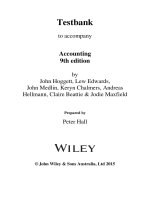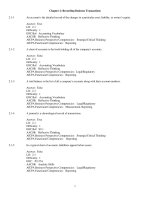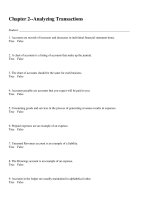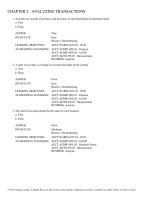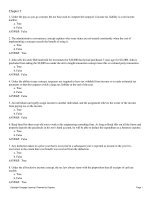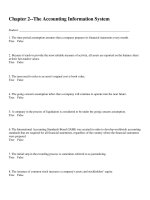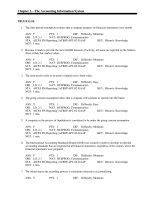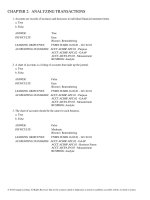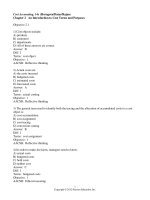Accounting 24th edition warren test bank
Bạn đang xem bản rút gọn của tài liệu. Xem và tải ngay bản đầy đủ của tài liệu tại đây (556.49 KB, 125 trang )
Chapter 2--Analyzing Transactions
Student: ___________________________________________________________________________
1. Accounts are records of increases and decreases in individual financial statement items.
True False
2. A chart of accounts is a listing of accounts that make up the journal.
True False
3. The chart of accounts should be the same for each business.
True False
4. Accounts payable are accounts that you expect will be paid to you.
True False
5. Consuming goods and services in the process of generating revenues results in expenses.
True False
6. Prepaid expenses are an example of an expense.
True False
7. Unearned Revenues account is an example of a liability.
True False
8. The Drawings account is an example of an expense.
True False
9. Accounts in the ledger are usually maintained in alphabetical order.
True False
10. Depending on the account title, the right side of the account is referred to as the credit side.
True False
11. To determine the balance in an account, always subtract credits from debits.
True False
12. The double-entry accounting system records each transaction twice.
True False
13. The increase side of all accounts is the normal balance.
True False
14. Transactions are initially entered into a record called a journal.
True False
15. The process of recording a transaction in the journal is called journalizing.
True False
16. Journalizing is the process of entering amounts in the ledger.
True False
17. Transactions are listed in the journal chronologically.
True False
18. Journalizing transactions using the double-entry bookkeeping system will eliminate fraud.
True False
19. Liability accounts are increased by debits.
True False
20. Expense accounts are increased by credits.
True False
21. Revenue accounts are increased by credits.
True False
22. The normal balance of a capital account is a debit.
True False
23. The normal balance of the drawing account is a debit.
True False
24. The normal balance of an expense account is a credit.
True False
25. The normal balance of revenue accounts is a credit.
True False
26. Withdrawals decrease owner's equity and are listed on the income statement as a deduction from revenue.
True False
27. For a month's transactions for a typical medium-sized business, the salary expense account is likely to have
only credit entries.
True False
28. For a month's transactions for a typical medium-sized business, the accounts payable account is likely to
have only credit entries.
True False
29. When a business receives a bill from the utility company, no entry should be made until the invoice is paid.
True False
30. An account has three parts to it; a title, an increase side, and a decrease side.
True False
31. The T account got its name because it resembles the letter “T.”
True False
32. The right hand side of a T account is known as a debit and the left hand side is known as a credit.
True False
33. A debit is abbreviated as Db and a credit is abbreviated as Cr.
True False
34. Debiting the cash account will increase the account.
True False
35. A credit to the cash account will increase the account.
True False
36. The cash account will always be debited.
True False
37. The recording of cash receipts to the cash account will be done by debiting the account.
True False
38. The recording of cash payments from the cash account is done by entering the amount as a credit.
True False
39. The balance of the account can be determined by adding all of the debits, adding all of the credits, and
adding the amounts together.
True False
40. When an owner contributes equipment to the business, he or she retains ownership of the property.
True False
41. Liabilities are debts owed by the business entity.
True False
42. The accounts payable account is listed in the chart of accounts as an asset.
True False
43. A drawing account represents the amount of withdrawals made by the owner.
True False
44. Revenues are equal to the difference between cash receipts and cash payments.
True False
45. Expenses use up assets or consume services in the process of generating revenues.
True False
46. Owner’s capital will be reduced by the amount in the drawing account.
True False
47. The journal includes both debit and credit accounts for each transaction.
True False
48. A transaction that is recorded in the journal is called a journal entry.
True False
49. Assets are increased with debits and decreased with credits.
True False
50. Liabilities are increased with debits and decreased with credits.
True False
51. Debits will increase Unearned Revenues and Revenues.
True False
52. All owner’s equity accounts record increases to the accounts with credits.
True False
53. Journal entries can have more than two accounts as long as the debits equal the credits.
True False
54. Normal balances are the side that increase the account balance.
True False
55. When an owner invests assets in the business, the capital account increases due to revenue being earned.
True False
56. When an accounts payable account is paid in cash, the owner's equity in the business decreases.
True False
57. When an account receivable is collected in cash, the total assets of the business increase.
True False
58. The process of transferring the data from the journal to the ledger accounts is posting.
True False
59. The post reference notation used in the ledger is the account number.
True False
60. The post reference notation used in the journal is the page number.
True False
61. A notation in the post reference column of the general journal indicates that the amount has been posted to
the ledger.
True False
62. The order of the flow of accounting data is (1) record in the ledger, (2) record in the journal, (3) prepare the
financial statements.
True False
63. The process of transferring the debits and credits from the journal entries to the accounts is known as
“updating the accounts”.
True False
64. Journalizing eliminates fraud.
True False
65. Once journal entries are posted to accounts, each account will show a new balance after each entry.
True False
66. A group of related accounts that make up a complete unit is called a trial balance.
True False
67. A trial balance determines the accuracy of the numbers.
True False
68. Even when a trial balance is in balance, there may be errors in the individual accounts.
True False
69. The totals at the bottom of the trial balance and the totals at the bottom of the balance sheet both show
equality and balancing, and therefore should be equal.
True False
70. A proof of the equality of debits and credits in the ledger at the end of an accounting period is called a
balance sheet.
True False
71. If the trial balance is in balance, it can be assumed that all journal entries were posted correctly and no
errors were made.
True False
72. Posting a part of a transaction to the wrong account will cause the trial balance totals to be unequal.
True False
73. The erroneous arrangement of digits, such as writing $45 as $54, is called a slide.
True False
74. Journalizing a transaction with both the debit and the credit for $69 instead of $96 will cause the trial
balance to be out of balance.
True False
75. Posting a transaction twice will cause the trial balance totals to be equal.
True False
76. The erroneous moving of an entire number one or more spaces to the right or left, such as writing $85 as
$850, is called a transposition.
True False
77. Accounts
A. do not reflect money amounts
B. are not used by entities that manufacture products
C. are records of increases and decreases in individual financial statement items
D. are only used by large entities with many transactions
78. Accounts are classified in the ledger
A. chronologically
B. alphabetically
C. in accordance with their appearance in the financial statements
D. so that accounts used most often are listed first
79. Revenue should be recognized when
A. cash is received
B. the service is performed
C. the customer places an order
D. the customer charges an order
80. Which of the following accounts is an owner's equity account?
A. Cash
B. Accounts Payable
C. Prepaid Insurance
D. Ross Morris, Capital
81. The gross increases in owner's equity attributable to business activities are called
A. assets
B. liabilities
C. revenues
D. net income
82. A chart of accounts is
A. the same as a balance sheet
B. usually a listing of accounts in alphabetical order
C. usually a listing of accounts in financial statement order
D. used in place of a ledger
83. The debit side of an account
A. depends on whether the account is an asset, liability or owner's equity
B. can be either side of the account depending on how the accountant set up the system
C. is the right side of the account
D. is the left side of the account
84. An account is said to have a debit balance if
A. the amount of the debits exceeds the amount of the credits
B. there are more entries on the debit side than on the credit side
C. its normal balance is debit without regard to the amounts or number of entries on the debit side
D. the first entry of the accounting period was posted on the debit side
85. Which statement(s) concerning cash is (are) true?
A. cash will always have more debits than credits
B. cash will never have a credit balance
C. cash is increased by debiting
D. all of the above
86. A debit may signify a(n)
A. decrease in asset accounts
B. decrease in liability accounts
C. increase in the capital account
D. decrease in the drawing account
87. Which of the following types of accounts have a normal credit balance?
A. assets and liabilities
B. liabilities and expenses
C. revenues and liabilities
D. capital and drawing
88. Which of the following groups of accounts have a normal debit balance?
A. revenues, liabilities, capital
B. capital, assets
C. liabilities, expenses
D. assets, expenses
89. Which one of the statements below is not a purpose for the journal?
A. to show increases and decreases in accounts
B. to show a chronological order by date
C. to show a complete transaction in one place
D. to help locate errors
90. A credit may signify a
A. decrease in assets
B. decrease in liabilities
C. decrease in capital
D. decrease in revenue
91. A debit signifies a decrease in
A. assets
B. expenses
C. drawing
D. revenues
92. Which of the following applications of the rules of debit and credit is true?
A. decrease Prepaid Insurance with a credit and the normal balance is a credit
B. increase Accounts Payable with a credit and the normal balance is a debit
C. increase Supplies Expense with a debit and the normal balance is a debit
D. decrease Cash with a debit and the normal balance is a credit
93. Which of the following describes the classification and normal balance of the fees earned account?
A. asset, credit
B. liability, credit
C. owner's equity, debit
D. revenue, credit
94. The classification and normal balance of the accounts payable account is
A. an asset with a credit balance
B. a liability with a credit balance
C. owner's equity with a credit balance
D. revenue with a credit balance
95. The classification and normal balance of the drawing account is
A. an expense with a credit balance
B. an expense with a debit balance
C. a liability with a credit balance
D. owner's equity with a debit balance
96. The classification and normal balance of the supplies expense account is a(n)
A. asset with a debit balance
B. asset with a credit balance
C. expense with a debit balance
D. liability with a credit balance
97. In which of the following types of accounts are increases recorded by debits?
A. assets, liabilities
B. drawing, liabilities
C. expenses, liabilities
D. assets, expenses
98. In which of the following types of accounts are increases recorded by credits?
A. revenues, liabilities
B. drawing, assets
C. liabilities, drawing
D. expenses, liabilities
99. In which of the following types of accounts are decreases recorded by debits?
A. assets
B. revenues
C. expenses
D. drawing
100. In which of the following types of accounts are decreases recorded by credits?
A. liabilities
B. owner's capital
C. drawing
D. revenues
101. A credit balance in which of the following accounts would indicate a likely error?
A. Fees Earned
B. Salary Expense
C. Janet James, Capital
D. Accounts Payable
102. A debit balance in which of the following accounts would indicate a likely error?
A. Salaries Expense
B. Notes Payable
C. Edgar Martin, Drawing
D. Supplies
103. Randomly listed below are the steps for preparing a trial balance:
(1)
(2)
(3)
(4)
Verify that the total of the Debit column equals the total of the Credit column.
List the accounts from the ledger and enter their debit or credit balance in the Debit or Credit column of the trial balance.
List the name of the company, the title of the trial balance, and the date the trial balance is prepared.
Total the Debit and Credit columns of the trial balance.
What is the proper order of these steps?
A. (3), (2), (4), (1)
B. (2), (3), (4), (1)
C. (3), (2), (1), (4)
D. (4), (3), (2), (1)
104. Which of the following entries records the payment of an account payable?
A. debit Cash; credit Accounts Payable
B. debit Accounts Receivable; credit Cash
C. debit Cash; credit Supplies Expense
D. debit Accounts Payable; credit Cash
105. Which of the following entries records the investment of cash by Ron York, owner of a proprietorship?
A. debit Ron York, Capital; credit Accounts Receivable
B. debit Cash; credit Ron York, Capital
C. debit Ron York, Drawing; credit Cash
D. debit Cash; credit Ron York, Drawing
106. Which of the following entries records the receipt of a utility bill from the water company?
A. debit Utilities Expense; credit Accounts Payable
B. debit Utilities Payable; credit Accounts Receivable
C. debit Accounts Payable; credit Cash
D. debit Accounts Payable; credit Utilities Payable
107. Which of the following entries records the withdrawal of cash by Sue Martin, owner of a proprietorship,
for personal use?
A. debit Sue Martin, Capital; credit Cash
B. debit Sue Martin, Drawing; credit Cash
C. debit Salaries Expense; credit Cash
D. debit Salaries Expense; credit Salaries Payable
108. Office supplies were sold by Ari’s Alarm Service at cost to another repair shop, with cash
received. Which of the following entries for Ari’s Alarm Service records this transaction?
A. Office Supplies, debit; Cash, credit
B. Office Supplies, debit; Accounts Payable, credit
C. Cash, debit; Office Supplies, credit
D. Accounts Payable, debit; Office Supplies, credit
109. Office supplies purchased by Ari’s Alarm Service on account were returned. Which of the following
entries for Ari’s Alarm Service records this transaction?
A. Cash, debit; Office Supplies, credit
B. Office Supplies, debit; Accounts Receivable, credit
C. Accounts Payable, debit; Office Supplies, credit
D. Office Supplies, debit; Accounts Payable, credit
110. Cash was paid by Ari’s Alarm Service to creditors on account. Which of the following entries for Ari’s
Alarm Service records this transaction?
A. Cash, debit; Ari Fleish, Capital, credit
B. Accounts Payable, debit; Cash, credit
C. Accounts Receivable, debit; Cash, credit
D. Accounts Payable, debit; Account Receivable, credit
111. The process of initially recording a business transaction is called
A. trial balancing
B. posting
C. journalizing
D. balancing
112. Which of the following entries records the acquisition of office supplies on account?
A. Office Supplies, debit; Cash, credit
B. Cash, debit; Office Supplies, credit
C. Office Supplies, debit; Accounts Payable, credit
D. Accounts Receivable, debit; Office Supplies, credit
113. Which of the following entries records the payment of rent for the current month?
A. Cash, debit; Rent Expense, credit
B. Rent Expense, debit; Cash, credit
C. Rent Expense, debit; Accounts Receivable, credit
D. Accounts Payable, debit; Rent Expense, credit
114. Which of the following entries records the receipt of cash from patients on account?
A. Accounts Payable, debit; Fees Earned, credit
B. Accounts Receivable, debit; Fees Earned, credit
C. Accounts Receivable, debit; Cash, credit
D. Cash, debit; Accounts Receivable, credit
115. Which of the following entries records the collection of cash from cash customers?
A. Fees Earned, debit; Cash, credit
B. Fees Earned, debit; Accounts Receivable, credit
C. Cash, debit; Fees Earned, credit
D. Accounts Receivable, debit; Fees Earned, credit
116. Which of the following entries records the receipt of cash for two months' rent? The cash was received in
advance of providing the service.
A. Prepaid Rent, debit; Rent Revenue, credit.
B. Cash, debit; Unearned Rent, credit.
C. Cash, debit; Prepaid Rent, credit.
D. Cash, debit; Rent Expense credit.
117. A patient has a physical examination and asks the bookkeeper to mail the bill. The bookkeeper should
A. make no entry until the cash is received
B. Cash, debit; Accounts Receivable, credit
C. Cash, debit; Fees Earned, credit
D. Accounts Receivable, debit; Fees Earned, credit
118. Proof that the dollar amount of the debits equals the dollar amount of the credits in the ledger means
A. all of the information from the journal was correctly transferred to the ledger
B. all accounts have their correct balances in the ledger
C. only the journal is accurate; the ledger may be incorrect
D. only that the debit dollar amounts equal the credit dollar amounts
119. Which of the following is true about a T-Account?
A. Left hand side of the T-Account is called a debit.
B. Left hand side of the T-Accounts is called a credit
C. Right hand side of the T-Account is called a debit
D. None are true.
120. Which of the following abbreviations are correct?
A. Debit “Dr”, Credit “Cd”
B. Debit “Db”, Credit “Cr”
C. Debit “Db”, Credit “Cd”
D. Debit “Dr”, Credit “Cr”
121. Which side of the account increases a cash account?
A. credit
B. neither a debit or a credit
C. debit
D. either a debit or a credit
122. A cash payment is recorded on the cash account as a
A. neither a debit or a credit
B. credit
C. debit
D. either a debit or a credit
123. The balance of the account is determined by
A. adding all of the debits to all of the credits.
B. always subtracting the debits from the credits.
C. always subtracting the credits from the debits.
D. adding all of the debits, adding all of the credits, and then subtracting the smaller sum from the larger sum.
124. A list of the accounts is called
A. ledger
B. chart of accounts
C. T-Account
D. Debit
125. On the chart of accounts, the balance sheet accounts are normally listed in the following order
A. liabilities, assets, owner’s equity
B. assets, liabilities, owner’s equity
C. owner’s equity, assets, liabilities
D. assets, owner’s equity, liabilities
126. In which order are the accounts listed in the chart of accounts?
A. assets, expenses, liabilities, owners’ equity, revenues
B. owners’ equity, assets, liabilities, revenues, expenses
C. assets, liabilities, owner’ equity, revenues, expenses
D. assets, liabilities, revenues, expenses, owners’ equity
127. Which are the parts of the T account?
A. title, date, total
B. date, debit side, credit side
C. title, debit side, credit side
D. title, debit side, total
128. Which of the following is not a correct rule of debits and credits?
A. assets, expenses and withdrawals are increased by debits
B. assets are decreased by credits and have a normal debit balance
C. liabilities, revenues and owner’s equity are increased by credits
D. the normal balance for revenues and expenses is a credit
129. Prarie Clinic purchased X-ray equipment for $4,000, paid $1,275 down, with the remainder to be paid
later. The correct entry would be
A. Equipment
1,275
Cash
1,275
B. Cash
1,275
Accounts Payable
2,725
Equipment
4,000
C. Equipment Expense
4,000
Accounts Payable
1,275
Cash
2,725
D. Equipment
4,000
Accounts Payable
2,725
Cash
1,275
130. The chart of accounts is designed to
A. alphabetize the accounts to make reading easier for its financial statement users.
B. analyze the accounts and organize them in order of dollar amount to simplify the accounting information for
users.
C. summarize the transactions and determine their ending balances.
D. meet the information needs of a company and other financial statement users.
131. Which group of accounts is comprised of only assets?
A. Cash, Accounts Payable, Buildings
B. Accounts Receivable, Revenue, Cash
C. Prepaid Expenses, Buildings, Patents
D. Unearned Revenues, Prepaid Expenses, Cash
132. Of the following which istrue about assets?
A. Assets include physical and intangible assets.
B. Assets include only physical assets.
C. Assets are owned solely by the owner of the company.
D. Assets are the result of selling products or services to customers.
133. Which of the following is not considered to be a liability?
A. Wages Payable
B. Accounts Receivable
C. Unearned Revenues
D. Accounts Payable
134. Which of the following statements is not true about liabilities?
A. Liabilities are debts owed to outsiders.
B. Account titles of liabilities often include the term “payable”.
C. Cash received before services are performed are considered to be liabilities.
D. Liabilities do not include wages owed to employees of the company.
135. The owner’s equity will be reduced by all of the following accounts except:
A. Revenues
B. Expenses
C. Drawing account
D. All are true.
136. Expenses can result from:
A. increasing owner’s equity.
B. consuming services.
C. using up liabilities.
D. all are true.
137. The chart of accounts classify the accounts to make identification of the accounts easier. This is done by
way of assigning a number to each account. The first number identifies the classification of the type of
account. Which of the following indicates the use of this classification?
A. 1-Assets, 2-Liabilities, 3-Owner’s Equity, 4-Expenses, 5-Revenues
B. 1-Assets, 2-Liabilities, 3-Owner’s Equity, 4-Revenues, 5-Expenses
C. 1-Assets, 2-Owner’s Equity, 3-Revenues, 4-Expenses, 5-Drawing
D. 1-Owner’s Equity, 2-Drawing, 3-Revenues, 4-Expenses
138. The ____ is where a transaction can first be found on the accounting records.
A. chart of accounts
B. income statement
C. balance sheet
D. journal
139. The process of recording a transaction in the journal is called
A. recording
B. journalizing
C. posting
D. summarizing
140. Joshua Scott invests $65,000 into his new business. How would the journal entry for this transaction be
entered in the journal?
A. Cash
65,000
Joshua Scott, Capital
65,000
Invested cash in business
B. Cash
65,000
Joshua Scott, Capital
65,000
Invested cash in business
C. Joshua Scott, Capital
65,000
Cash
65,000
Invested cash in business
D. Joshua Scott, Capital
65,000
Cash
65,000
Invested cash in business
141.
April
23
Cash
Jim Xu, Capital
Invest cash in Xu Co.
14,000
14,000
The journal entry will:
A. Increase Capital and decrease Cash
B. Increase Cash and decrease Capital
C. Increase Cash and increase Capital
D. Decrease Cash and decrease Capital
142.
May
24
Land
Cash
Purchased land for business
53,000
53,000
What effects does this journal entry have on the accounts?
A. Increase to Cash and increase to Land
B. Increase to Land and decrease to Cash
C. Decrease to Cash and decrease to Land
D. Increase to Cash and decrease to Land
143.
May
31
Supplies
Accounts Payable
????????????
120
120
What is the best explanation for this journal entry?
A. Purchased supplies with cash
B. Investment of supplies by owner
C. Purchased supplies on account
D. Paid accounts payable.
144.
March
10
Accounts Payable
Cash
Paid creditors on account
3,300
3,300
What effect does this journal entry have on the accounts?
A. Decrease accounts payable, increase cash
B. Increase cash, decrease accounts payable
C. Increase accounts payable, increase cash
D. Decrease accounts payable, decrease cash
145. Which of the following accounts would be increased with a credit?
A. Land, Accounts Payable, Drawing
B. Accounts Payable, Unearned revenue, Collins Capital
C. Collins Capital, Accounts Receivable, Unearned Revenue
D. Cash, Accounts Receivable, Collins Capital
146. In accordance with the debit and credit rules, which of the following is true?
A. Debits increase assets.
B. Credits increase assets.
C. Debits increase both assets and capital.
D. Credits increase both assets and liabilities.
147. All of the following accounts are increased with a debit except:
A. Unearned Revenues
B. Land
C. Accounts Receivable
D. Cash
148. Which of the following owner’s equity accounts follow the same debit and credit rules as liabilities?
A. Expense accounts only
B. Drawing accounts only
C. Revenues accounts only
D. Expenses and drawing accounts
149. The payment for the monthly rent will require the following entry
A. Debit Cash and Debit Rent Expense
B. Credit Cash and Credit Rent Expense
C. Debit Rent Expense and Credit Cash
D. Credit Rent Expense and Debit Cash
150. Expenses follow the same debit and credit rules as
A. Revenues
B. Drawing Account
C. Capital Account
D. Liabilities
151. Net income will result when
A. revenues (credits) > expenses (debits)
B. revenues (debits) > expenses (credits)
C. expenses (credits) < revenues (debits)
D. revenues (credits) = expenses (debits)
152. Which of the following will increase owner’s equity?
A. Expenses > revenues
B. the owner draws money for personal use
C. Revenues > expenses
D. Cash is received from customers on account.
153. Which of the following situations increase owner’s equity?
A. Supplies are purchased on account.
B. Services are provided on account.
C. Cash is received from customers.
D. Utility bill will be paid next month.
154. Which of the following group of accounts are increased with a debit?
A. assets, liabilities, owner’s equity
B. assets, drawing, expenses
C. assets, revenues, expenses
D. assets, liabilities, revenues
155. Which of the following group of accounts increase with a credit?
A. Capital, revenues, expenses
B. Assets, capital, revenues
C. Liabilities, capital, revenues
D. None of these
156. Which of the following is true regarding normal balances of accounts?
A. All accounts have a normal debit balance.
B. The normal balance of all accounts will have either a positive or negative balance.
C. Accounts that have a normal debit balance will only have debit entries, never credit entries.
D. The normal balance is the side of the account that increases the account.
157. All of the following occur with a double-entry accounting system except:
A. The accounting equation remains in balance.
B. The sum of all debits is always equal to the sum of all credits in each journal entry.
C. Each business transaction will have only two entries.
D. Every transaction affects at least two accounts.
158.
March
6
Cash
Unearned Fees
????????????
375
375
What is the best explanation for this journal entry?
A. Received cash for services performed
B. Received cash for services to be performed in the future.
C. Paid cash in advance for services to be done.
D. Paid cash for services to be performed.
159.
April
14
Equipment
Cash
Note Payable
????????????
6,700
2,000
4,700
Which is the best explanation for this journal entry?
A. Purchased equipment, paid cash of $2,000, with the remainder to be paid in payments.
B. Purchased equipment, paid cash of $4,700, with the remainder to be received in the future.
C. Purchased equipment, paid cash for the entire amount.
D. Purchased equipment on credit.
160. The process of rewriting the information from the journal into the ledger is called
A. sliding
B. transposing
C. journalizing
D. posting
161. The verification that the total dollar amount of the debits equals the total dollar amount of the credits in the
ledger is called a
A. ledger
B. trial balance
C. account
D. balance sheet
162. The process of transferring the journal entries to the accounts is known as
A. posting
B. updating
C. journalizing
D. summarizing
163. The posting process will include the transfer of the following information from the journal to the account.
A. date, amount (debit or credit)
B. date, amount (debit or credit), journal page number
C. amount (debit or credit), account number
D. date, amount (debit or credit) account number
164. The post reference columns are used to trace transactions from the journal to the accounts. What will be
posted on the post reference column of (a) the journal and (b) on the account?
A. (a) the amount of the debit or credit (b) the journal page number
B. (a) the journal page number (b) the date of the transaction
C. (a) the journal page number, (b) the account number
D. (a) the account number, (b) the journal page number
165. The chart of account for the Corning Company includes some of the following accounts:
Account Name
Cash
Accounts Receivable
Prepaid Insurance
Accounts Payable
Unearned Revenue
Corning, Capital
Corning, Drawing
Fees Earned
Salaries Expense
Rent Expense
Account Number
11
13
15
21
24
31
32
41
54
56
On the journal page 3, the following transaction was found:
Prepaid Insurance
Cash
1,530
1,530
What is the post reference that will be found on the cash account?
A. 11
B. 15
C. 3
D. None
166. The chart of account for the Corning Company includes some of the following accounts:
Account Name
Cash
Accounts Receivable
Prepaid Insurance
Accounts Payable
Unearned Revenue
Corning, Capital
Corning, Drawing
Fees Earned
Salaries Expense
Rent Expense
Account Number
11
13
15
21
24
31
32
41
54
56
On the journal page 3, the following transaction was found:
Prepaid Insurance
Cash
1,530
What is the post reference that will be found on the Prepaid Insurance account?
A. 11
B. 15
C. 3
D. None
1,530
